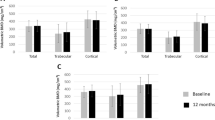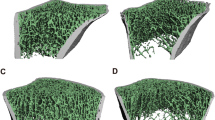Abstract
Summary
Rheumatoid arthritis (RA) has been associated with osteoporosis. Quantitative computed tomography (QCT) is capable of assessing bone density and composition. We found lower bone density in RA compared to controls. Age and RA duration influenced bone density. QCT may be useful to assess bone metabolism in RA.
Introduction
RA is associated with generalized and periarticular osteoporosis. In addition to DXA that determines areal bone mineral density (BMD), peripheral QCT also detects volumetric BMD. QCT differentiates between total, trabecular, and cortical BMD. Here, we compared DXA and QCT in RA patients and healthy controls.
Methods
BMD of 57 female RA patients and 32 age-matched healthy female controls were assessed by DXA. QCT of the forearm ultradistal region was also performed. Densitometry data were correlated with age, disease duration, disease activity, serum CRP, and anti-CCP levels.
Results
Total bone density (310.4 ± 79.7 versus 354.0 ± 54.1 mg/cm3; p = 0.007) and attenuation (0.37 ± 0.05 versus 0.40 ± 0.03 1/cm; p = 0.001), trabecular density (157.6 ± 57.0 versus 193.8 ± 48.7 mg/cm3; p = 0.005) and attenuation (0.28 ± 0.03 versus 0.32 ± 0.04 1/cm; p < 0.0001), and cortical density (434.3 ± 115.8 versus 492.5 ± 64.0 mg/cm3; p = 0.006) and attenuation (0.44 ± 0.07 versus 0.47 ± 0.04 1/cm; p = 0.004) were significantly lower in RA. Both lumbar and femoral neck BMD, as well as T-scores, were significantly lower in RA versus controls (p < 0.001 in all cases). In RA, total and cortical QCT attenuation and density were associated with age, the presence of RA, and their combination. In contrast, trabecular density and attenuation were only affected by the presence of the disease but not by age. Also in RA, total trabecular and cortical density as determined by QCT significantly correlated with lumbar and/or femoral neck BMD as measured by DXA. Finally, anti-CCP seropositivity was associated with lower trabecular density and attenuation.
Conclusions
Both DXA and QCT may be suitable to study bone metabolism in RA. Areal BMD determined by DXA may correlate with volumetric bone density measured by QCT. Moreover, trabecular osteoporosis may be associated by the underlying autoimmune-inflammatory disease, while cortical osteoporosis may rather be age-related.


Similar content being viewed by others
References
Harris ED Jr (1990) Rheumatoid arthritis. Pathophysiology and implications for therapy. N Engl J Med 322:1277–1289
Goldring SR (2002) Bone and joint destruction in rheumatoid arthritis: what is really happening? J Rheumatol Suppl 65:44–48
Goldring SR (2002) Pathogenesis of bone erosions in rheumatoid arthritis. Curr Opin Rheumatol 14:406–410
Deal C (2012) Bone loss in rheumatoid arthritis: systemic, periarticular, and focal. Curr Rheumatol Rep 14:231–237
Takayanagi H (2009) Osteoimmunology and the effects of the immune system on bone. Nat Rev Rheumatol 5:667–676
Schett G, Hayer S, Zwerina J, Redlich K, Smolen JS (2005) Mechanisms of disease: the link between RANKL and arthritic bone disease. Nat Clin Pract Rheumatol 1:47–54
Daoussis D, Andonopoulos AP, Liossis SN (2010) Wnt pathway and IL-17: novel regulators of joint remodeling in rheumatic diseases. Looking beyond the RANK-RANKL-OPG Axis. Semin Arthritis Rheum 39:369–383
Diarra D, Stolina M, Polzer K, Zwerina J, Ominsky MS, Dwyer D et al (2007) Dickkopf-1 is a master regulator of joint remodeling. Nat Med 13:156–163
Schett G, Zwerina J, David JP (2008) The role of Wnt proteins in arthritis. Nat Clin Pract Rheumatol 4:473–480
Guler-Yuksel M, Allaart CF, Goekoop-Ruiterman YP, de Vries-Bouwstra JK, van Groenendael JH, Mallee C et al (2009) Changes in hand and generalised bone mineral density in patients with recent-onset rheumatoid arthritis. Ann Rheum Dis 68:330–336
Peel NF, Spittlehouse AJ, Bax DE, Eastell R (1994) Bone mineral density of the hand in rheumatoid arthritis. Arthritis Rheum 37:983–991
Ardicoglu O, Ozgocmen S, Kamanli A, Pekkutucu I (2001) Relationship between bone mineral density and radiologic scores of hands in rheumatoid arthritis. J Clin Densitom 4:263–269
Haugeberg G, Lodder MC, Lems WF, Uhlig T, Orstavik RE, Dijkmans BA et al (2004) Hand cortical bone mass and its associations with radiographic joint damage and fractures in 50-70 year old female patients with rheumatoid arthritis: cross sectional Oslo-Truro-Amsterdam (OSTRA) collaborative study. Ann Rheum Dis 63:1331–1334
Joffe I, Epstein S (1991) Osteoporosis associated with rheumatoid arthritis: pathogenesis and management. Semin Arthritis Rheum 20:256–272
Szekanecz Z, Elek I, Bettembuk P, Szegedi G (1998) Secundaer osteoporosis rheumatoid arthritisben. Magyar Belorv Arch 51:267–271
Magrey M, Khan MA (2010) Osteoporosis in ankylosing spondylitis. Curr Rheumatol Rep 12:332–336
Haugeberg G (2008) Focal and generalized bone loss in rheumatoid arthritis: separate or similar concepts? Nat Clin Pract Rheumatol 4:402–403
Genant HK, Ettinger B, Cann CE, Reiser U, Gordan GS, Kolb FO (1985) Osteoporosis: assessment by quantitative computed tomography. Orthop Clin North Am 16:557–568
Genant HK, Block JE, Steiger P, Glueer CC, Smith R (1987) Quantitative computed tomography in assessment of osteoporosis. Semin Nucl Med 17:316–333
Engelke K, Adams JE, Armbrecht G, Augat P, Bogado CE, Bouxsein ML et al (2008) Clinical use of quantitative computed tomography and peripheral quantitative computed tomography in the management of osteoporosis in adults: the 2007 ISCD official positions. J Clin Densitom 11:123–162
Felder M, Ruegsegger P (1991) Bone patients with rheumatoid arthritis—effect of steroids measured by low dose quantitative computed tomography. Rheumatol Int 11:41–44
Saario R, Sonninen P, Mottonen T, Viikari J, Toivanen A (1999) Bone mineral density of the lumbar spine in patients with advanced rheumatoid arthritis. Influence of functional capacity and corticosteroid use. Scand J Rheumatol 28:363–367
Eser P, Aeberli D, Widmer J, Moller B, Villiger PM (2010) Abnormal bone geometry at the metacarpal bone shaft of rheumatoid arthritis patients with maintained muscle-bone relationship. Arthritis Care Res (Hoboken) 63:383–389
Zhu TY, Griffith JF, Qin L, Hung VW, Fong TN, Kwok AW et al (2012) Bone density and microarchitecture: relationship between hand, peripheral, and axial skeletal sites assessed by HR-pQCT and DXA in rheumatoid arthritis. Calcif Tissue Int 91:343–355
Prevoo ML, van ‘t Hof MA, Kuper HH, van Leeuwen MA, van de Putte LB, van Riel PL (1995) Modified disease activity scores that include twenty-eight-joint counts. Development and validation in a prospective longitudinal study of patients with rheumatoid arthritis. Arthritis Rheum 38:44–48
Acknowledgments
This work is supported by the OTKA 105073 research grant by the Hungarian Scientific Research Fund (H.P.B.), by the TÁMOP 4.2.4.A/2-11-1-2012-0001 National Excellence Program cofinanced by the European Union and Hungary (Z.S.), by research grant TÁMOP-4.2.2.A-11/1/KONV-2012-0031 financed by the European Union (Z.S.), and by a Bridging Fund from the University of Debrecen Faculty of Medicine (Z.S.).
Author information
Authors and Affiliations
Corresponding author
Ethics declarations
Ethics statement
The study received an Institutional Review Board approval and assessments were carried out according to the Declaration of Helsinki. An informed consent was obtained from each patient.
Conflicts of interest
None.
Rights and permissions
About this article
Cite this article
Juhász, B., Gulyás, K., Horváth, Á. et al. Comparison of peripheral quantitative computed tomography forearm bone density versus DXA in rheumatoid arthritis patients and controls. Osteoporos Int 28, 1271–1277 (2017). https://doi.org/10.1007/s00198-016-3850-x
Received:
Accepted:
Published:
Issue Date:
DOI: https://doi.org/10.1007/s00198-016-3850-x




